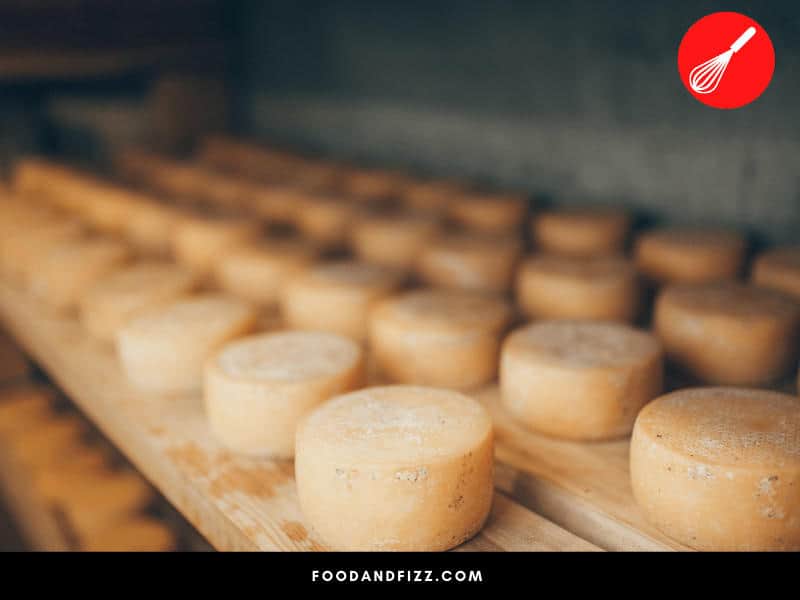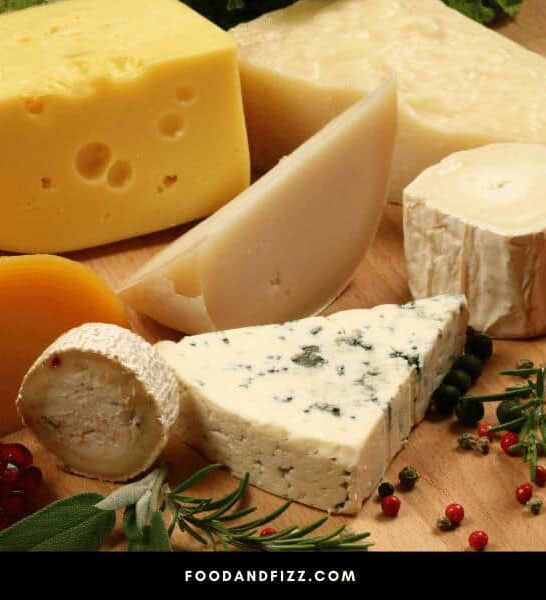Some arguments, possibly the vast majority, emerge from a difference of opinion.
Others develop from misunderstands that appear to be differences of opinion but, in fact, are nothing save a miscommunication because of a misapplication of terms.
In considering whether or not cheese is “expired” milk, there is a great danger of falling into a trap simply because we haven’t taken either the time or trouble to carefully explain precisely what we mean by “expired” milk.
Is Cheese Expired Milk?
Cheese is not expired milk. Rather, cheese is milk cultured to allow certain types of bacteria to turn milk’s sugars into lactic acid. In turn, lactic acid acts on casein, another natural component of milk, to turn the casein into curdles, which form the basis of cheese. Further processes turn the curdles into edible cheese. On the other hand, expired milk is milk in which bacteria have begun to digest the lactose but not yet to the point that the milk forms curdles.

Let them eat cheese
Marie Antoinette, the famous (infamous?) French queen who suffered the somewhat emphatic misadventure of literally losing her head is reputed to once have said, “Let them eat cake.”
This piece of advice–highly disputed in many academic circles–was supposedly aimed at revolting French peasants, by which I mean French peasants who were being querulous, not French peasants whose presence made you want to throw up.
Anyway, if she really did say it, Marie Antoinette based her ill-timed and misjudged suggestion on the faulty assumption that cake was relatively easy to come by.
The English proverb, “If wishes were horses, beggars would ride,” couldn’t have been more apt in the circumstances.
So, according to the queen, all the French peasants (whether of the revolting-rebelling or revolting-disgusting kind) would have had to do was wish for cake, and then all that unfortunate palaver of the French revolution would have been avoided, in turn sparing Madame le Guillotine a lot of work.
Alas, cake isn’t easy to come by, wishes aren’t horses, and cheese is not expired milk.
The point I’ve labored to make–apologies–is that if cheese was only expired milk, then all we would need to do is set some milk aside, let it “expire,” and voila!
We’d have as much cheese as we could possibly eat and, no doubt, vats of the stuff to gift to family, friends, and even complete strangers.
But–and here’s the nub–expired milk is still milk; it is undoubtedly not cheese.

This is what happens to milk when it expires
If you are going by the “Sell by,” or “Use by,” or “Best by” label on the package or bottle of milk, then nothing very much happens with the passage of that date.
The milk will still smell and taste perfectly fine because it is.
However, I’m going to emphasize something here because it is so important: the milk will still smell and taste perfectly fine as long as it has been stored continuously in a fridge.
With good, uninterrupted refrigeration, milk can last for days beyond its expiry date, which is the manufacturer’s recommendation for freshness.**
When milk finally expires, it takes on an unpleasant pong and horrible taste.
Your nose will most likely complain very pungently, and should you be silly enough to still put the foul-smelling milk into your mouth, your tongue won’t be best pleased either.
Between these two senses, we seem to have been born with an innate ability to tell when bacterial activity in milk has reached a point with negative, possibly even fatal ramifications. (See “A word about unpasteurized milk” below.)
**Under no circumstances, imagine that I am telling you to ignore the labeling on food packages, whether of milk or any other product. You may not take anything I have written in this article to mean that you can ignore manufacturers’ food label instructions. If you do so, you do it entirely at your own risk.

This is what does not happen to milk when it expires
When milk expires, it smells a bit “funny” and tastes sour.
The waste from–and toxins released by–the myriad bacteria that made a home in the milk has reached saturation level, spoiling the former sweet goodness that gives milk its taste.
The result, expired milk, is what we call sour milk, and we describe it as “milk that has gone off.” What we absolutely do not do is call it cheese.
A word about unpasteurized milk
Because I have mentioned bottled or packaged milk and manufacturers’ labels, I believe whenever I say “milk,” we are both thinking of milk that has come into our household from a licensed manufacturer.
Such milk has been pasteurized–put through a heating process designed to kill naturally occurring pathogens in farm milk.
When pasteurized milk expires, everything is as I have described previously.
However (and this is vital), when it comes to unpasteurized milk, it’s a whole new ball game.
Expired unpasteurized milk could easily be a haven for dangerous, possibly even lethal, bacteria like E. coli.
Drinking expired unpasteurized milk is playing Russian roulette with your life–don’t do it. (Honestly, do yourself a huge favor and don’t drink unpasteurized milk, period!)

Expired milk can be useful
One surprising thing that does not happen to expired pasteurized milk is that it does not always get thrown out.
Many folks use expired milk (which some call sour milk) in their cooking.
Because of its extra acidity, sour milk or expired milk, or whatever the heck you want to call it, is a handy buttermilk substitute.
Expired milk goes from sour milk and handy buttermilk to a clumpy, gooey substance that looks and smells absolutely horrendous, and I have no choice but to doff my virtual hat to whoever it was that first had enough chutzpah to wonder if that goo was edible.
As it turns out, whoever that nut was, s/he had discovered a crude form of cheese.
Where cheese comes from
As I explained earlier, milk expires when bacterial waste becomes overwhelming.
Specifically, the bacteria ingest and digest lactose, the sugar in milk. What goes in has to come out; in this case, the bacterial output is lactic acid. This extra acidity is what makes sour milk a practical buttermilk alternative.
However, lactic acid acts on another milk component, casein, in a reaction that causes the casein to curdle into separate lumps. This curdled part of milk smells sour and “off.”
Curdled milk is, therefore, the “extremely expired” part of milk we use to make cheese.
The difference is that clumpy, lumpy expired milk has made a cheese-like substance by accident, whereas cheese manufacturers make the substance on purpose and use many processes, both natural and artificial, to create their cheese delights.

Cheese vs. spoilt milk
If cheese comes from super-expired milk, does that mean it comes from spoilt milk? The answer is a resounding “No!”
To understand the difference, recognize that milk has two components: proteins and sugar (lactose).
When bacteria digest lactose, they excrete lactic acid, which curdles the milk. We call this expired milk. In time, expired milk turns into cheese.
When bacteria digest milk proteins, they excrete poisonous substances, and the milk smells positively malodorous.
This smell is off-putting, far more than the disagreeable smell of expired milk, and we call this type of milk “rotten.”
Fortunately for us, the bacteria which digest milk proteins are not the same as the ones which digest lactose.
In a way, the distinction reflects our perceptions and prejudices. In our gardens, we love flowers but despise weeds, even though weeds have flowers.
In our milk, although victimized in both cases by (different) bacteria, we love cheese but despise “spoilage.”

